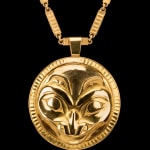BILL REID (IIJUWAS), O.B.C., R.C.A. (1920-1998), HAIDA
signed, "Reid '72";
inscribed with artist's Wasgo (Haida Seawolf);
numbered, "5/10";
further inscribed, "22 k".
the chain: testing 22 kt gold, 24.25 in (61.6 cm) in length, 36 g, signed and dated, "Reid 88".
Further images
The renowned Haida artist Iljuwas Bill Reid is celebrated as among the most significant Northwest Coast Native artists of the twentieth century. He is best known for the revitalization of Haida arts and techniques, and the marriage of modern form and Haida visual heritage from his own ancestry and learned through the deep close study of historic examples.
A one-time CBC radio broadcaster, Reid pursued deep training in European jewelry and goldsmithing techniques, including later study that he undertook at the Central School of Design in London in 1968. In 1970, a year after moving to Montreal and founding a jewelry workshop, Reid built on his new training and began using the lost-wax method to produce exquisite pieces such as this Grizzly Medallion, wholly cast in gold. The lost-wax technique allowed Reid to emulate the solidity and sculptural plasticity of Haida monumental carving but on the miniature scale of jewelry. He could thus marry the sculptural accomplishments of Haida crest poles and wooden sculpture, like his familiar Bear Sculpture (c. 1963), with the intimacy of engraved bracelets worn as personal adornment and crest displays, such as those by his great-great-uncle Daxhiigang (Charles Edenshaw, 1839-1920), the master Haida artist whose work Reid greatly emulated.
While many of Reid’s early works are direct adaptations of historic examples, including regular recreations of his great-great-uncle’s designs, Grizzly Medallion demonstrates his confidence in marrying classic Haida form with modern innovation. The bear’s face emerges in high relief from the circular medallion, snout overhanging the ribbed rim, a decorative motif that Reid has adapted from argillite dishes by Daxhiigang. The motif is extended here to the sections of the medallion’s intricate chain, linking the wearer to the wide-eyed grizzly through this shared framing, creating an effect of stacked faces in a typically Haida style.
Christopher T. Green, PhD
References: The Grizzly Medallion and a very similar chain is illustrated in Karen Duffek, Bill Reid: Beyond the Essential Form, (Vancouver: University of British Columbia Press, 1986), fig. 24, p. 15, as "Gold medallion with chain, Grizzly bear, 1972, (5.1 cm diameter)." It is conceivable that it is this lot but no edition number is given in Duffek’s book. See Mary Ann Lash, “New Life is Given to the Craft of Haida Jewelry,” Canadian Art Magazine, vol. 14, no. 3, Spring 1957, pp. 101-103 for early examples of the artist's works.
Provenance
Douglas Reynolds Gallery, Vancouver, BC;Acquired from the above by John and Joyce Price, Seattle, WA.
Publications
An edition (this work?) is reproduced in Karen Duffek, Bill Reid: Beyond the Essential Form, (Vancouver: University of British Columbia Press, 1986), fig. 24, p. 15, as "Gold medallion with chain, Grizzly Bear".Join our mailing list
* denotes required fields
We will process the personal data you have supplied in accordance with our privacy policy (available on request). You can unsubscribe or change your preferences at any time by clicking the link in our emails.










